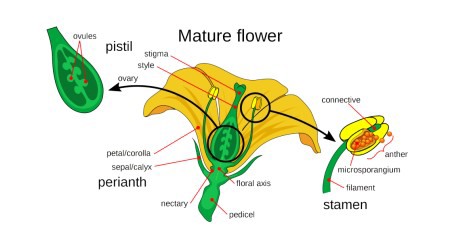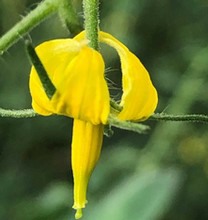Pollination is the single most important aspect for both yield and quality, also in semi-closed greenhouses. Reason enough for Godfrey Dol, specialist in growing in semi-closed greenhouses, to share information about what pollination is, guidelines and methods.
What is pollination?
The formation of fruit is the product of a plants reproductive system. The fruits are a tasty prospect for animals who spread the seed far and wide. But before the fruit was formed, it was a flower.
The flower of a tomato plant has both the male DNA (anther, which produces pollen) and female DNA (stigma, which receives the pollen) of the species. They are separated by a few millimeters only, but without the pollen traveling from the anther to the stigma, a tomato will not form properly. Pollination is the story of how pollen travels this short distance.

Pollination guidelines
Pollination is a process that in nature is helped by wind, insects or small animals. It is a natural process and it is therefore no surprise that there are physical limitations.
One of the most clearly defined guidelines in the glasshouse industry is the optimum temperature range for pollination of tomato plants. At temperatures of more than 28 degrees Celsius, the pollination degrades and above 32 degrees there are serious implications on yield and quality. Growers want to keep the glasshouse temperature below 28 degrees for this reason.
It is one of the main reasons why glasshouses have flourished in cool climates, and why others are built at high altitude. It is also the reason the semi-closed glasshouse is embraced in warm climates while in the Netherlands, it suffered a cool reception.
Cool climates and forced cooling allow for the maximum temperature in the glasshouse to be reduced below the danger levels for pollination.
At the lower end of the spectrum, pollination also has a minimum day time temperature limit of 16 degrees Celsius below which the pollen is not viable.
The second limitation is in humidity. At low humidity, the pollen is too dry and does not stick to the stigma. At high humidity, the pollen sticks to the stamen and does not fall onto the stigma.
In conventional glasshouses, the recommended humidity range is 60-75%. Due to better air movement, the range in a semi-closed glasshouse is 70-85%.
Recognize the signs
There are also upper limits for the 24-hour temperature, above which pollination is compromised, regardless of light levels. For larger fruiting tomato plants such as beefsteak and truss tomatoes on the vine, an average 24-hour temperature of more than 21 degrees Celsius has adverse effects on pollination.
Smaller fruiting tomato plants such as cherry and snacking tomatoes suffer pollination problems above 23 degrees Celsius.
Individual varieties can have a different 24-hour temperature above which the pollination is compromised. When temperatures are above these thresholds, any means to reduce the day or night temperature must be used. This includes using cooling at night.
One typical physical feature of when the 24-hour temperature is too high is called stigma exsertion and is shown in figure 1. The stigma is sticking out of the flower. This is where the pollen is supposed to be deposited, but because it protrudes the protection that the flower provides, pollination is not possible.
The picture in figure 1 is a tell-tale sign that the 24-hour temperature is too high. Damage can already occur before this symptom is noticed. It should not be confused with daytime temperatures higher than 30 degrees. Fig 1; The Stigma protruding through the protective flower cone because of high 24-hour temperature.
Fig 1; The Stigma protruding through the protective flower cone because of high 24-hour temperature.
It is important to point out that exposure to maximum temperatures of more than 30 degrees for a couple of hours will have negligible effect on pollination. Nor does one day of average 24-hour temperature of more than 21 degrees. However, a full day above 30 degrees, or consecutive days with a maximum temperature above 30 degrees Celsius will affect pollination.
If the temperature reaches 40 degrees Celsius for one hour there is an immediate effect. For a high 24-hour temperature to have effect on pollination takes at least a one to two weeks. Similarly, for pollination to return to normal will take two weeks of cool weather.
Flower temperature
Understandably the effect of temperature on pollination is related to flower temperature. The temperatures stated above relate to glasshouse air temperature, which is what is usually measured. The flower temperature is assumed to be as much as 5 degrees higher than the air temperature. This is dependent on radiation. Hence, a high 24-hour temperature has less effect on pollination when radiation is low, states Godfrey. Plants that are younger also seem to be able to withstand higher 24-hour temperatures.
How important is pollination
All the protection that a glasshouse provides, helps to produce good quality fruit. Without proper pollination, however, the investment of a glasshouse, heating, fertilizer, and labor, is reduced to nothing. Poorly pollinated fruit have less seed, become soft, have a shorter shelf life, and appear dull.
The glasshouse needs to produce a high percentage of premium fruits to be profitable. Without proper pollination, the percentage of waste and second-class fruits goes up, increasing the cost per kilo and the carbon footprint.
When bumblebees are used properly, the pollination is usually perfect except for when external conditions are extreme, as discussed earlier.
In a few countries, bumblebees are not available and manual pollination must be used. Due to the cost of labor involved in growers are tempted to save on pollination cost. It pays to remember the statement above that without proper pollination a tomato plant will not produce premium fruit.
Manual pollination
When tomato plants are pollinated manually, the best method is by using electric bees. These are battery operated vibrators. Staff must vibrate every plant in the glasshouse three times per week. It is tempting to revert to other means of pollination (tapping crop wires, tapping plants with an irrigation hose, tapping strings with an irrigation hose, banging the gutter with a stick or using a blower mounted to a trolley), as it is much cheaper.
Under cool, dry circumstances, this can result in adequate pollination. However, when the weather is cloudy or rainy, these other methods do not suffice.
In Australia, where bumblebees are not allowed, the annual labor cost of pollination with electric bees is as much as 35,000 Euros per hectare per year. However, losing one truss cost more than 35,000 Euros. Hence the insistence in providing the plants with the correct pollination method. A fruit that is poorly set, cannot be turned into a premium fruit.
A better way to ensure proper pollination is to make sure labor is available to pollinate with electric bees on (cloudy or rainy) days when pollination is difficult and pollinate with cost-effective means on good days. This requires a flexible workforce which is not easy to achieve.
It also needs to be noted that beefsteak and TOV tomatoes are much more difficult to pollinate manually compared to cherry, cocktail, and snacking tomatoes.
This article is the first in a series of three about pollination. Last year Godfrey already started with a series about growing in a semi-closed greenhouse. Read here more about no-go's for semi-closed glasshouses, cooling, the difference between semi-closed and pad and fan glasshouses and how to prevent momentum, becoming a crop to vegetative and humidity, for example in tomato. The last updates in the series were about a higher humidity at night and CO2 increases and the effect on crops.
For more information:
Glasshouse Consultancy
www.glasshouse-consultancy.com
Godfrey Dol
LinkedIn
godfrey@glasshouse-consultancy.com
+81 80 700 94 006
